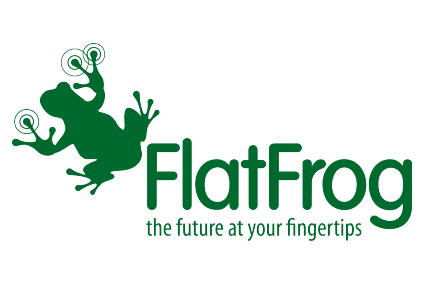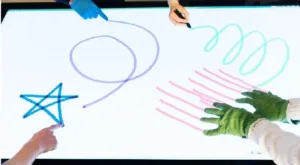This week, I spent a day at the BETT exhibition in London, where many of those involved in educational technology come together. What I found was something of a breakthrough in large display touch technology.

BETT is a great place to see interactive displays as educationalists have been using interactive displays, usually projectors, for years and the UK has the best market for educational touch displays in Europe. If you’re in the UK, you could still get along to the event, which is open until Saturday 28th January.
However, developing high quality touch technology for large direct view displays that met all the desires of users and makers has been a challenge. Since touch was developed, there have been many touch technologies that have been used for different applications, each with key advantages for particular applications. Then, with great touch technology based on projected capacitive (PCap), Apple introduced everyone to very fast, good looking touch technology that really transformed the experience and established PCap as the dominant technology for touch.
Unfortunately, it was very hard to scale that technology up to larger sizes than tablets, notebooks and monitors. The ITO material (which is transparent and conductive) used in the sensors in small displays does not have low enough conductivity to work well in large sizes.
Materials, such as metal mesh, can be used, but these have disadvantages because they may be visible through the display (although 3M, for example, seems to have some good solutions to this challenge) or may have to be designed to match particular panel configurations. Other materials, such as carbon nanotubes and nanobuds (e.g. Canatu) and silver nanowires and particles (e.g. Cambrios and Cima Nanotech) turned out to be either too expensive when the price of ITO came down dramatically or too tricky for other reasons. Canatu changed direction away from large displays some time ago and both Cambrios and Cima are gone. We were optimistic that Cima would do well. It seemed to have good performance, both Ken and I were impressed with their demos and the firm had formed a J/V with Foxconn for manufacturing and had started to sign customers. However, it didn’t make it and closed for business last year.
Infrared Dominates
So, especially in the very price sensitive education market, the touch market is dominated by optical technologies based on infrared beams being blocked. These are not as good, in terms of speed etc, as PCap, but don’t block the display or interfere with the image quality – especially important as the market switches to UltraHD panels as panel makers stop making large FullHD panels. They also need bezels that protrude beyond the display, which goes against the trend for displays that are bezel-less or have a completely flat front surface.
 Back in 2010, in our subscription newsletter, we reported on an investment in a Swedish company, Flatfrog that had invented a new way of detecting touch. Light is injected into the edge of a glass sheet and bounces around using total internal reflection (TIR). When a stylus or finger touches the surface, this reflection is broken, so by tracking the break in the TIR, you can detect the touch – and the size of the touch. (Dialog Semiconductor makes chips that track the TIR). The system works fast and can differentiate between different types of thin or thick stylii and can also detect palms. That’s important as it means that the technology can work with Microsoft’s stylus requirements. It can also use the area of the finger to sense pressure.
Back in 2010, in our subscription newsletter, we reported on an investment in a Swedish company, Flatfrog that had invented a new way of detecting touch. Light is injected into the edge of a glass sheet and bounces around using total internal reflection (TIR). When a stylus or finger touches the surface, this reflection is broken, so by tracking the break in the TIR, you can detect the touch – and the size of the touch. (Dialog Semiconductor makes chips that track the TIR). The system works fast and can differentiate between different types of thin or thick stylii and can also detect palms. That’s important as it means that the technology can work with Microsoft’s stylus requirements. It can also use the area of the finger to sense pressure.
At ISE 2015, the company showed that it could support much larger screens than we had seen before and we highlighted the firm as one of the most interesting items from ISE in 2015 as the company said that it could support displays over 100″ and also curved displays. We interviewed Nathan Moyal on video at the event.
BETTing on Optical
At BETT last year, VividTouch, the own brand displays from Steljes of the UK (and which has now become Avocor), showed a commercial product using the FlatFrog technology. Flatfrog added MMT of Gerrmany, a small integrator, and then in May last year, NEC showed a display using the technology at its London showcase. I wondered in an editorial in our subscription newsletter, last year, if the technology had finally reached an inflection point.
At BETT this week, we got confirmation that the inflection point had, indeed, been reached. As well as Avacor and NEC showing displays (NEC Announces the InfinityBoard for a Creative and Collaborative Meeting Experience), again, they were joined by Smart, Promethean (which was one of the very early investors in FlatFrog before being taken over itself) and Dell, who have all added the technology to the high end of their interactive ranges. That’s an impressive list with two of the biggest and highly regarded suppliers in this market and Dell, which is steadily building up a portfolio of larger displays.
The demos that we got were, mostly, extremely good with a range of different stylii.
We plan to catch up with FlatFrog at ISE in a couple of weeks and no doubt there will be more news then. – Bob Raikes

